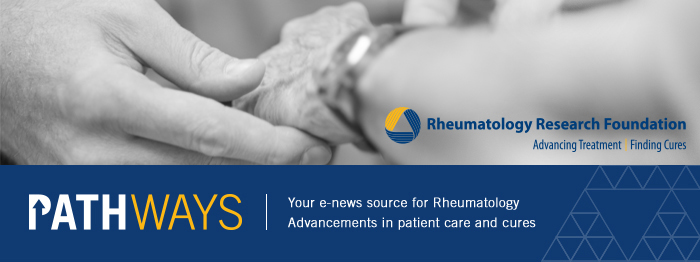Pathways

Volume 6 • Issue 1 • January 2017 • Rheumatology Research Foundation
Developing a Robust Career in Rheumatology
Demand for rheumatologists is expecting a 46 percent increase by 2025 with rheumatic and autoimmune diseases on the rise, while the number of practicing rheumatologists is projected to increase by only 1.2 percent. That means patients might have to wait even longer to see a rhuematologist, prolonging a proper diagnosis.
Through training programs to encourage medical students and residents to choose rheumatology as their subspecialty and career development awards that support young rheumatologists, the Rheumatology Research Foundation is actively working to combat the unprecedented need for treatment and care.
Jeffrey Sparks, MD, MMSc of Brigham and Women’s Hospital and Harvard Medical School, received a Scientist Development Award from the Foundation, which enables early career rheumatologists to pursue research in rheumatology. As Dr. Sparks says, the awards are “geared towards helping patient care” because they embolden early career rheumatologists who often have a strong clinical background without experience in disease investigation.
The Foundation awarded more than $10 million for the 2017 fiscal year, $4,725,000 of which funded career development. For more information on the full range of awards offered by the Foundation for career development, click here.
Visit the improving patient care page to to read more stories, or share your experience by emailing us.
#RheumLife: Recognizing Rare Disease

The initial symptoms of rheumatic disease can be vague, mimicking other conditions. For physicians not trained in the specialty, misinterpretations of these symptoms can lead to a misdiagnosis. Rarer conditions face an even greater risk of being overlooked. Research into the nuances of the rarer forms of rheumatic disease can curb their misdiagnoses, thereby enabling patients to seek critical treatment sooner.
|
 Jane Songhurst Jane Songhurst
|
Patient Perspective
“The first symptom I had was terrific pain in my right hip joint a few weeks after giving birth to my child. I was 21 years old, the doctor prescribed anti-inflammatory medication and told me it was ligaments not settling properly after birth. I’m 56 years old now and have Anklyosing Spondylitis and every joint in my body is affected, including fusing of my sacroiliac joint and spine.”
|
 Dr. Jessica Ann Walsh Dr. Jessica Ann Walsh
|
The Efforts to Help
Jessica Ann Walsh, MD is studying Axial Spondyloarthritis (AxSpA) diagnosis and treatment at the University of Utah. AxSpA is a spectrum of under-recognized inflammatory diseases characterized by chronic back pain; these diseases impair quality of life and may impact mortality. Currently, methods to identify AxSpA are limited, which hinders treatment. The goals of Dr. Walsh’s research are to develop ways for doctors to more easily identify and improve the lives of people like Jane.